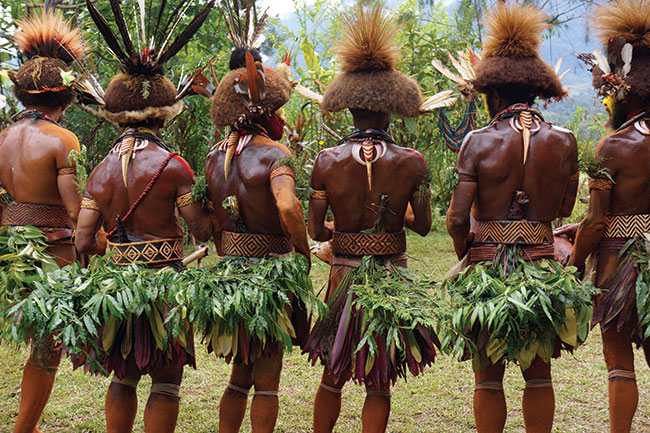
Text and photographs by Mary L. Peachin
Vol. 21, No. 6, February 2018
Scuba diving with sharks, an unexpected encounter with a saltwater crocodile, snorkeling with humpbacks and whalesharks, photographing grizzly and polar bear, traveling to all seven continents. On a regular basis, I am asked which or where is my favorite adventure or destination. In my most recent book, Celebrating 20 Years! , I have highlighted many of these places. To simplify the process, this newsletter, well into its 21st year, will focus on some of my very favorite destinations. If I had to choose an activity, I would share that scuba diving is my passion following by all kinds of fishing then bicycling. At the same time, I find cultures fascinating along with some of their delectable cuisines. It’s a tough choice, but here is a start.
Papua New Guinea
Papua New Guinea, the world’s largest tropical island country of rugged mountains and thick jungles, is home to four million Papuans, Melanesians Micronesians, and Polynesians who speak more than 700 distinct languages. North of Australia, it is located across the Coral Sea’s Torres Strait. Our small group, led by veteran Papua New Guinea expert, Greg Stahakis, met in the capitol city of Port Moresby.
Our tour took us first to Timbunke village and the Karawari rainforest vegetation of the Sepik River. Traveling by chartered plane to Mount Hagen, we attended the annual sing-sing celebrating by tribes from across the country.
Following a visit to Madang, we flew to Tari’s Ambua Lodge in the Southern Highlands, home of the infamous Huli tribesmen. In this region we visited tribal villages, a witch doctor, the bachelor village of Kaka, and by happenstance viewed a bride price negotiation along the road. We also had the opportunity to hike through the rainforest in search of Birds of Paradise.
Twelve of us shared a lifetime two-week adventure. Sadly, we said “lookim yu behind” or farewell to Papua New Guinea in pidgin. (Read more)
MB link to https://peachin.com/adventuring-in-papua-new-guinea/
Also the book title above to Amazon
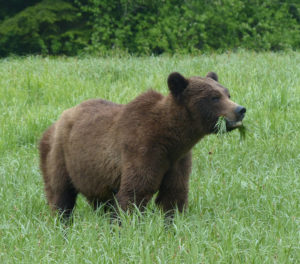
Khutzeymateen’s Grizzlies in the Mist
Danger doesn’t come from the direction of the water. So Big Mama, when not nursing her yearling cub, hungrily chews on long stalks of sedge grass just 10 feet from our zodiac. Dan Wakeman’s twenty years of observing yearly life cycles in British Columbia’s Khutzeymateen, North America’s largest grizzly bear sanctuary, has provided him the opportunity to visually bond with many of its grizzlies. Those decades of experience have enabled Dan to share his intimate knowledge of grizzly habits and many of their individual personalities with wildlife lovers – especially photographers.
It’s early June and still mating season. This male is on the prowl for a female. Not being the dominant male (Barney is the Valley’s “stud”) he’ll have to “get lucky” to find an eligible female, one without a cub, one who is also in estrus. He might kill her cub, but he won’t mate with her until her hormones make her fertile.
“I’ve known these bears since they were cubs,” Dan says, adding that summers in the Khutzeymateen have been a “labor of love.” Life on the 40- foot sloop, Sunchaser, typically moored in Cedar Creek, is planned around the tide, when the water is deep enough to navigate up the estuary. High tide affords the best opportunity to view bears. Dan is dependent on Inland Charters to fly in his clients and many of his supplies. (Read More)
A Saltwater Croc Encounter in the Solomon Islands
A dangerous saltwater crocodile had been previously sighted in the underwater cave called “Mirror Pond” on Mane, one of many mangrove islands in the Russell chain in the Solomon Islands.
“We do not know the behavior of this man-eating crocodile,” stressed Scott Waring, divemaster on the Spirit of the Solomons liveaboard diveboat. “When he has been seen in the cave, he is usually lying on one of the many ledges. Waring advised us that the crocodile had previously attacked a snorkeler, but it had never bothered a scuba diver. He added “as you follow me into the 250-foot underwater passageway to the cave, please leave me plenty of room to escape!”
Waring’s wife, Diane, added, “It’s only a small croc and it isn’t always there.” Confidence bolstered, I decided that I was up to this scuba diving encounter. Perhaps, foolishly, five of us felt that there was “safety in numbers.” Those steel tanks on our backs made us feel invincible.
The five intrepid ones included divemaster Waring, James Forte, a professional underwater photographer, Zim Gervais, a videographer, Karen Haugen, a nurse, and myself. Haugen and I brought up the rear, figuring in case of an evacuation, it was “last in, first out.” (Read More)
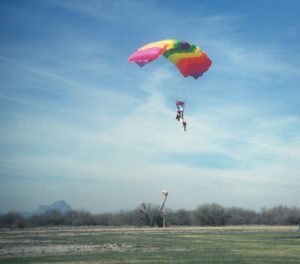
Skydiving in Marana – Bungee Jumping in Cairns, Australia
Standing on a ten-story tower gazing over Australia’s Great Barrier Reef, preparing to jump with one’s ankles tied together, offers even the most daring a new perspective on life. Was I scared… or, more to the point, how scared was I?
The continuous question, “Mary, have you ever bungee jumped?” was wearing thin. As a world traveler and adventurer, I had enjoyed scuba diving with sharks, hiking through developing (and less-developed) countries, flying single-engine turbo aircraft, and more. The bungee question was becoming irritating, in the very least.
The questions about bungee jumping tantalized me. I decided to give them some thought on the twenty-mile bicycle ride down to A.J. Hackett’s in Smithfield, the founder of commercial bungee-jumping. I promised myself that it would be OK if I chickened out.
Yes, I steered my bicycle into to A.J. Hackett’s, where I weighed in, thankfully in kilometers. The number was drawn on my hands so the bungee masters would know how to adjust the rope to my weight. The next challenge was forcing my legs to climb 132 feet of steps to the top of the platform.
I could feel my knees wobbling below me. I was determined to reach the top of the tower and jump-without taking time to consider the consequences.
The timing didn’t work out that way. At the top, an Australian television station was shooting a special on the bungee trend, which took about fifteen minutes. My jump was furthered delayed when the woman in front of me freaked out on the platform and decided to walk down the stairs.
The wait had “iced” me. My legs were now like rubber bands. The bungee masters took no notice, wrapping my ankles in towels and binding them with cord.
Shuffling out to the platform, I knew if I looked down at the pool of water below me, I would never have the courage to jump. Instead, I kept my gaze on the beauty of the Great Barrier Reef.
5-4-3-2-1, jump! I balked. (Read More)
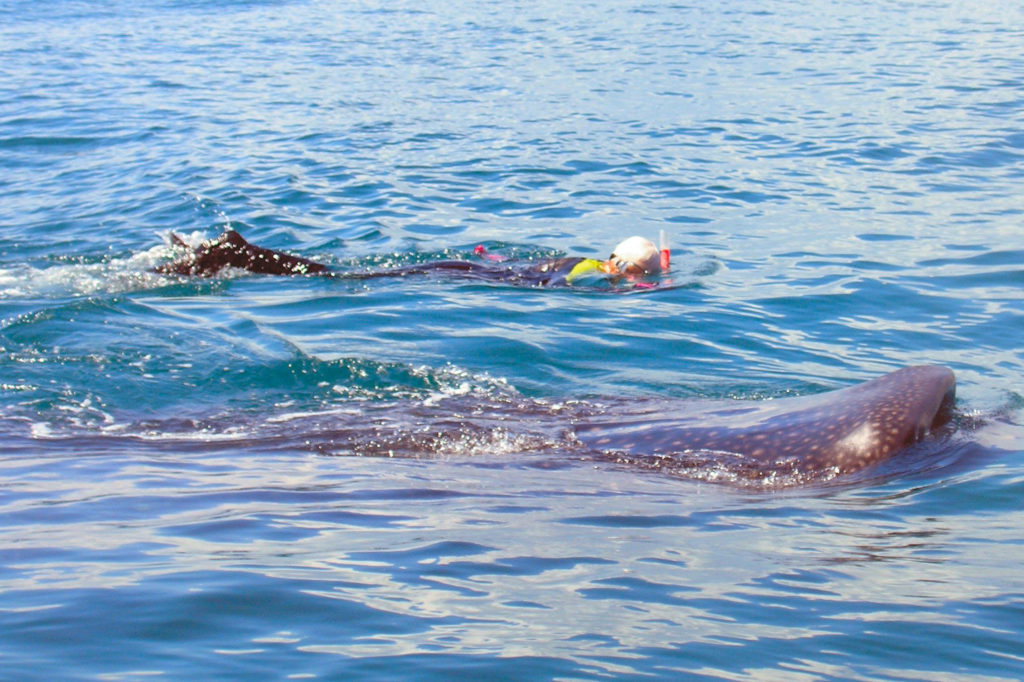
Whale Sharks of Holbox, Mexico
Entering the water directly in the whale shark’s path, I peered into its approaching mouth. A few feet away, its eyes appeared to check me out, or was that anthropomorphic.
The surface boiled. As many as sixty whale sharks, mouths agape, moved slowly around us in the plankton rich waters. Some fed in circles, giving us a second or even a third encounter, close up views with attached remoras dining on parasites. Schools of sardines, a frenetic bait ball breaking the surface, gobbled anything escaping the gaping mouth. Cobia, playing the roles of pilot fish, kept pace with the sharks strong strokes.
In August, my friends Bill Kimball, David Lovitt, Jan Hansen and I visited Holbox. Two of us would slide into the 79-degree water whenever one or two whale sharks approached just for the thrill of observing and photographing them.
Visibility ranged between twenty five and thirty feet, enough to give us a great view, but not enough to capture the shark’s full length with our digital and video equipment. We each made at least half a dozen entries, lasting up to fifteen minutes each. As two of us came out, the mate helped us up a side ladder as the boat idled. (Read More)
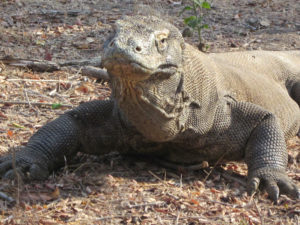
Indonesia’s Arenui Diving and Komodo Dragons
Biting to kill, once the Komodo, the world’s largest monitor lizard, gets a taste of blood, it is impossible to separate it from its prey. Its toxic saliva produces a deadly bacterial infection, one that that slowly kills larger animals. Once the animal dies, even the hide will be devoured. They have no predators.
Komodo’s congregate while feeding or mating. Otherwise, they tend to fight with one another and cannibalize the young, weak and old. Hatchlings, to avoid being eaten, live in trees for two years.
The toxic saliva that kills other animals does not affect the Komodo. Older lizards often die from starvation. Researchers have recently discovered that, like snakes, Komodo’s also have venom that interacts with the saliva bacteria.
In Komodo National Park, Indonesia, an estimated 2,500 dragons live on five of the Park’s islands. They swim, propelled by their long tail, to inhabited islands.
By sunning in the daylight, they reach their optimal temperature. This provides them with energy to hunt. They can smell prey as far as seven miles away. Close to ten feet in length, they weigh as much as 150 pounds.
Females lay up to eighteen eggs which incubate for ten months. Mating begins between May and August, and eggs are laid in September. About twenty eggs are deposited in abandoned or self-dug nests.
The eggs are incubated for seven to eight months, hatching in April, a time when insects are most plentiful. Young Komodo dragons are vulnerable and therefore dwell in trees, safe from other predators and cannibalistic adults. They take about eight to nine years to mature, and are estimated to live for up to thirty years. (Read More)
After twenty years of monthly posting adventures on peachin.com, it’s a challenge to mention only a handful of great destinations. To read more, go to the website or read Celebrating 20 Years!
